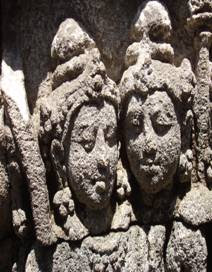
Early Javanese Society
Javanese society in AD 800 produced enough surplus food and labor to support a great deal of activity which did not produce direct economy benefits. The Javanese must have had abundant manpower to haul the stones, skilled craftsmen to carve them, and well organized institutions to coordinate such an ambitious and complex project.
All about the Javanese society can be learn from the panels in Borobudur temple and many other ancient’s temples in Java. There hundreds temples and archeological sites scattered in the island.
Traders along the silk route introduced Buddhism to China during the first centuries AD, and the new religion soon acquired a firm foothold beside the indigenous Chinese belief of Taoism and Confucianism. A sea link between India and China was forged around AD 400. This new route was opened by Indonesian sailors who had several centuries of experience in maritime trade with other parts of Southeast Asia and India. Buddhist pilgrims voyaged with increasing frequency through the archipelago during the 7th and 8th centuries. The records they have left tell us that java and Sumatra were major centers of International Buddhist scholarship during this period.
Above all, it is highly significant that they choose to devote a major portion of their resources to the constructions of a monument which, although it perhaps served several purposes, was principally a visual aid for teaching a gentle philosophy of life. Certainly this qualifies ancient Java as one of the most humanistic societies in history.
No traces of ancient palaces or even cities have been found in central Java, leading historians to believe that the Javanese lived in villages of approximately equal size, and that most of the inhabitants made their living as farmers. The fertile soil and plentiful water of the Kedu plain surrounding Borobudur must have supported a prosperous farming population, and this may have been what attracted the monument’s builders to this site. Buddhist sanctuaries usually included monasteries whose monks depended for the food on contributions from the surrounding populations.
Archeological evidence shows that flourishing community of laymen, as well clergy, lived in Borobudur’s environment.
Javanese society in AD 800 produced enough surplus food and labor to support a great deal of activity which did not produce direct economy benefits. The Javanese must have had abundant manpower to haul the stones, skilled craftsmen to carve them, and well organized institutions to coordinate such an ambitious and complex project.
All about the Javanese society can be learn from the panels in Borobudur temple and many other ancient’s temples in Java. There hundreds temples and archeological sites scattered in the island.
Traders along the silk route introduced Buddhism to China during the first centuries AD, and the new religion soon acquired a firm foothold beside the indigenous Chinese belief of Taoism and Confucianism. A sea link between India and China was forged around AD 400. This new route was opened by Indonesian sailors who had several centuries of experience in maritime trade with other parts of Southeast Asia and India. Buddhist pilgrims voyaged with increasing frequency through the archipelago during the 7th and 8th centuries. The records they have left tell us that java and Sumatra were major centers of International Buddhist scholarship during this period.
Above all, it is highly significant that they choose to devote a major portion of their resources to the constructions of a monument which, although it perhaps served several purposes, was principally a visual aid for teaching a gentle philosophy of life. Certainly this qualifies ancient Java as one of the most humanistic societies in history.
No traces of ancient palaces or even cities have been found in central Java, leading historians to believe that the Javanese lived in villages of approximately equal size, and that most of the inhabitants made their living as farmers. The fertile soil and plentiful water of the Kedu plain surrounding Borobudur must have supported a prosperous farming population, and this may have been what attracted the monument’s builders to this site. Buddhist sanctuaries usually included monasteries whose monks depended for the food on contributions from the surrounding populations.
Archeological evidence shows that flourishing community of laymen, as well clergy, lived in Borobudur’s environment.
Comments
Post a Comment
Thanks for giving your comments and not spamming us. I will link to you as you link to me.